
Alessandria is a city and commune in Piedmont, Italy, and the capital of the Province of Alessandria. The city is sited on the alluvial plain between the Tanaro and the Bormida rivers, about 90 kilometres east of Turin.

Montferrat is a historical region of Piedmont, in northern Italy. It comprises roughly the modern provinces of Alessandria and Asti. Montferrat is one of the most important wine districts of Italy. It also has a strong literary tradition, including the 18th century Asti-born poet and dramatist Vittorio Alfieri and the Alessandrian Umberto Eco.
Judeo-Italian is an endangered Jewish language, with only about 200 speakers in Italy and 250 total speakers today. The language is one of the Italian languages and one of the Jewish Romance Languages. Some words have Italian prefixes and suffixes added to Hebrew words as well as Aramaic roots. All of the language's dialects except one are now extinct.
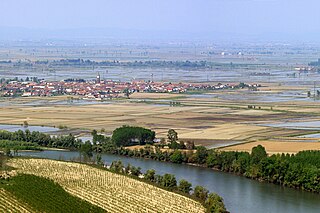
The province of Alessandria is an Italian province, with a population of some 425,000, which forms the southeastern part of the region of Piedmont. The provincial capital is the city of Alessandria.

The province of Asti is a province in the Piedmont region of Italy. Its capital is the city of Asti. To the northwest it borders on the Metropolitan City of Turin; to the southwest it borders on the province of Cuneo. To the east it borders on the province of Alessandria, while in the south it shares a very short border with the Ligurian province of Savona. It has an area of 1,504.5 square kilometres (580.9 sq mi), and, As of 2017, a total population of 215,871.

Casale Monferrato is a town in the Piedmont region of northwestern Italy, in the province of Alessandria. It is situated about 60 km (37 mi) east of Turin on the right bank of the Po, where the river runs at the foot of the Montferrat hills. Beyond the river lies the vast plain of the Po valley.
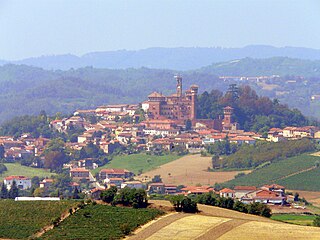
Cereseto is a comune (municipality) in the Province of Alessandria in the Italian region Piedmont.
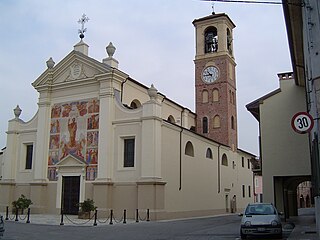
Morano sul Po is a comune in the province of Alessandria, Piedmont, northwestern Italy.
Odalengo Piccolo is a commune (comune) of the Province of Alessandria in the northwest Italian region Piedmont. It is located in the Val Cerrina about 40 kilometres (25 mi) east of Turin, about 13 kilometres (8 mi) north of Asti and some 20 kilometres (12 mi) southwest of Casale Monferrato. The municipality extends over an area of 7.63 square kilometres (2.95 sq mi) in the hills to the south of the Stura del Monferrato torrent, where areas of woodland are interspersed by vineyards. It borders on the communes of Alfiano Natta, Castelletto Merli, Cerrina Monferrato, Odalengo Grande, and Villadeati.

Pontestura is a commune with a population of 1,539 in the Province of Alessandria in the Italian region Piedmont. It is located on the right bank of the Po River about 50 kilometres (31 mi) east of Turin and about 10 kilometres (6 mi) west of Casale Monferrato and borders the following municipalities: Camino, Casale Monferrato, Cereseto, Coniolo, Morano sul Po, Ozzano Monferrato, Serralunga di Crea, and Solonghello.
San Giorgio Monferrato is a comune of the Province of Alessandria in the Italian region Piedmont. It is about 60 kilometres (37 mi) east of the regional capital Turin and about 25 kilometres (16 mi) northwest of Alessandria.
The history of the Jews in Turin, Italy, can be first traced to the 4th century when bishop Maximus of Turin recorded the presence of Jews in the city. The city of Turin is in north-west Italy and is the capital of the Piedmont region.
The Biella Synagogue is a Jewish congregation and synagogue, that is located at Vicolo del Bellone 3, in Biella, Piedmont, Italy. The synagogue was completed in 1780.

The Cherasco Synagogue is a former Jewish congregation and synagogue, that is located at Via Marconi 4, in Cherasco, Piedmont, Italy. Designed in the Baroque style, the synagogue was completed in the 18th century.
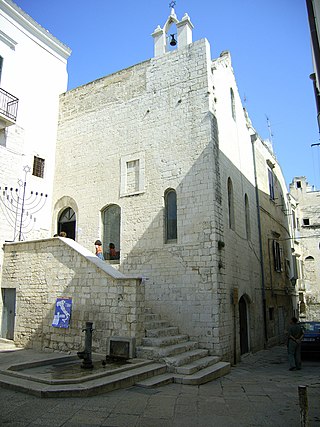
The Scolanova Synagogue is a Jewish congregation and synagogue, located at Via Sinagoga 47, in the town of Trani, Puglia in Italy. Built by the Italian–Jewish community of Apulia during the Middle Ages, the building was acquired by the Roman Catholic Church in 1380 during a wave of antisemitism and served as St. Maria's Church until it was deconsecrated and returned to the Jewish community in 2006.

The Scolagrande Synagogue is a Jewish congregation and synagogue, located at Via la Giudea 24, in the town of Trani, Puglia in Italy. Built by the Italian–Jewish community of Apulia during the Middle Ages and completed in 1247, the building was acquired by the Roman Catholic Church in 1380 and served as St. Anne's Church until it was deconsecrated and returned to the Jewish community in 2004.
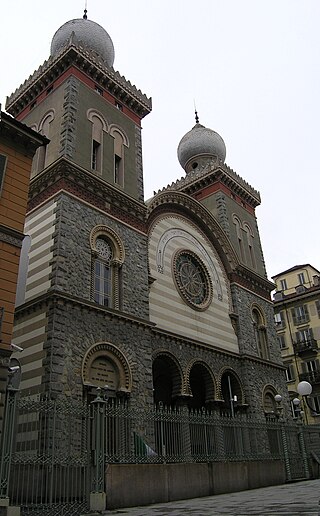
The Synagogue of Turin, also known as Israelite Temple, is a Jewish congregation and synagogue, that is located at 12 Via Pio V, in Trieste, Piedmont, Italy. Designed by Enrico Petiti in the Moorish Revival style, the synagogue was completed in 1884.
Noemi Gabrielli was an Italian art historian, superintendent, and a museologist.

The Jewish Museum of Florence is a museum of Jewish history located in the Great Synagogue of Florence, Italy. The museum, which covers two spaces of the building, gathers an important collection of ancient objects of Jewish ceremonial art, evidence of the high artistic level achieved by the Jewish-Italian communities in the field of applied arts. Exhibitions illustrate the history of Florentine Jews from the first settlements to the post-war reconstruction, featuring old photographs, films and a large number of objects of daily and commemorative use.

The Rijeka Orthodox Synagogue is an Orthodox Jewish synagogue, located on Ivan Filipović Street, formerly Galvani Street, in Rijeka in Croatia. The synagogue was built in a Rationalist style in 1931. It is one of the very few synagogues in Croatian territory to have survived the destruction of the Nazi period.















